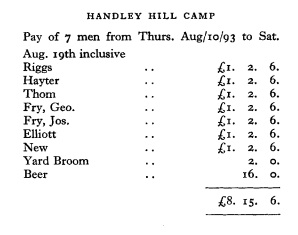To search the RPR site click here
In an article published in 1973, Richard Bradley (who later went on to excavate many of the same sites as Pitt-Rivers) gives an account of Pitt-Rivers' methodology on his Cranborne Chase excavations. His article was based upon the evidence provided by two of Harold St George Gray's field notebooks from the excavations then at Dorset County Museum:
For this series of excavations the General employed a labour force of between seven and fourteen and a staff of up to three. In 1894 there is an additional reference to ‘a boy named Cook who is engaged to wash pottery’. Work took place six days a week and normally commenced at 7 a.m., though this was occasionally relaxed in bad weather. Sometimes the men had already started work at 6.30 at the General’s Museum. Their attendance seems to have been rather irregular and there is a useful reminder of their rustic background when Gray remarks that the missing Hebdige had ‘left to go sheep shearing near Wimbourne’. The General’s appearances on the site were regular but equally unpredictable. At times he seems to have arrived even earlier than his men (Gray, 1905, xxvii). Though some had worked with him before, their reaction to such strange employment is nowhere explicit. There are hints, however, of some unrest at the master’s requirements on the Angle Ditch where four workmen left the site in eight days. The work was carried on at an extraordinary pace throughout and it may be well to remember this in assessing the published results. The Handley Hill enclosure, for example, was commenced on the morning of Thursday 10 August 1893 with seven men. By 3.30 on the Saturday the 900 sq. yds. (750 sq. m.) of the interior had been dug to the bedrock a foot (30cm.) below the surface, and by 19 August the entire bank and ditch had been removed. Barrow 24 with its associated urnfield of 51 burials was totally excavated in less than seven days, including an area of 1,250 sq. ft. (115 sq.m.) beyond the lip of the ditch. ... In spite of the rapidity of the work, the ageing General’s attention never flagged and special arrangements were adopted in his absence: ‘Several urns were found but in excavating them they came to pieces except one which was got out nearly entire & sent to Rushmore in the carriage.’
The illustration shows a table from the same article showing the pay given to the labourers working on the digs.
Bibliography for this article
Bradley, R. 1973 'Two Notebooks of General Pitt Rivers', Antiquity, 47 47-50.
AP, September 2011




